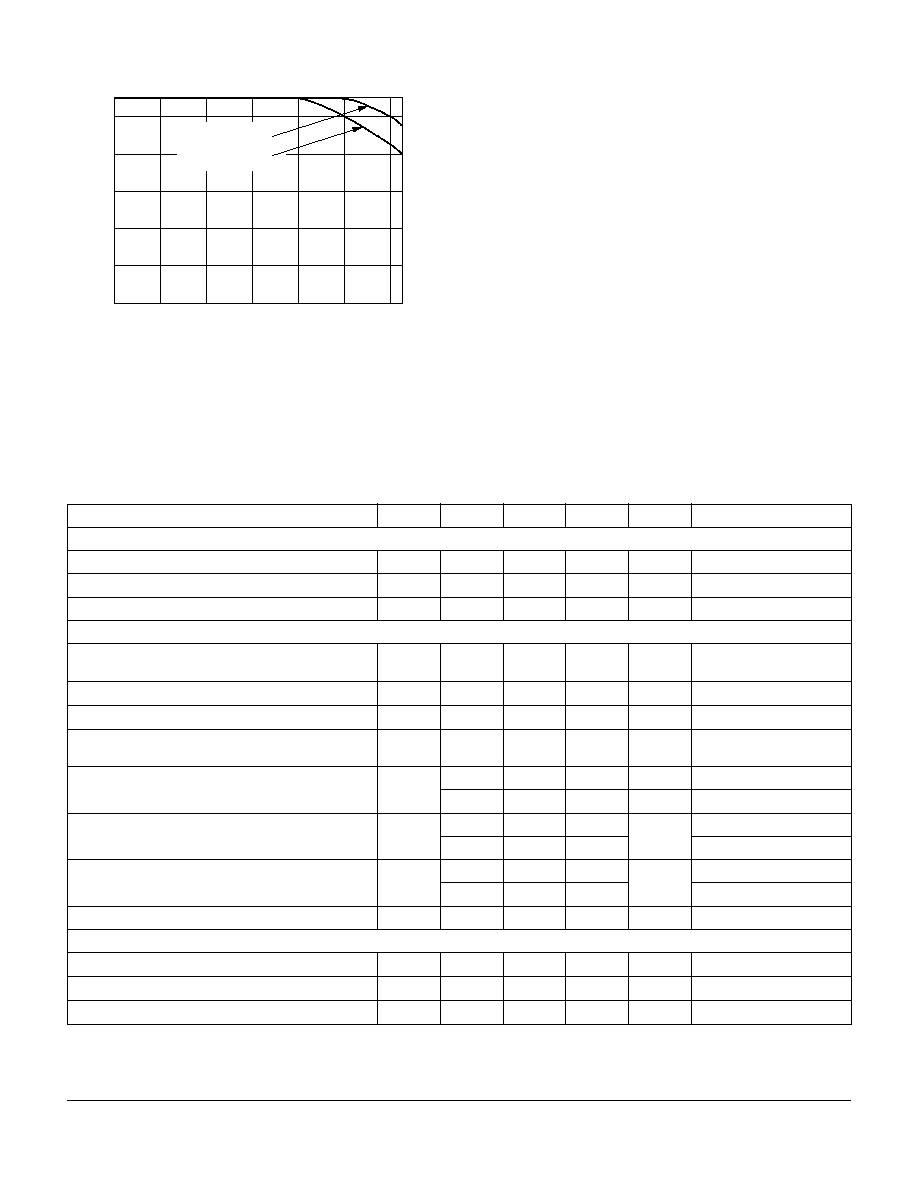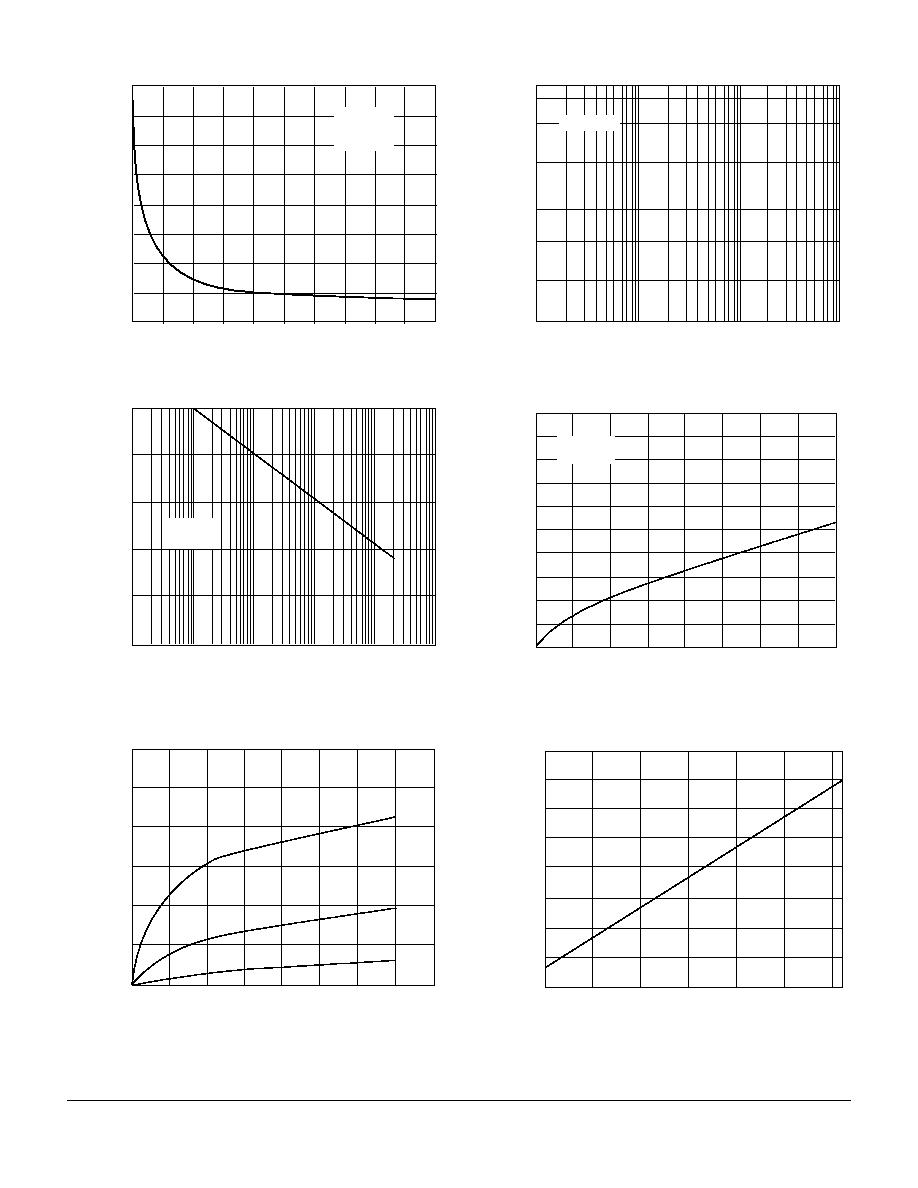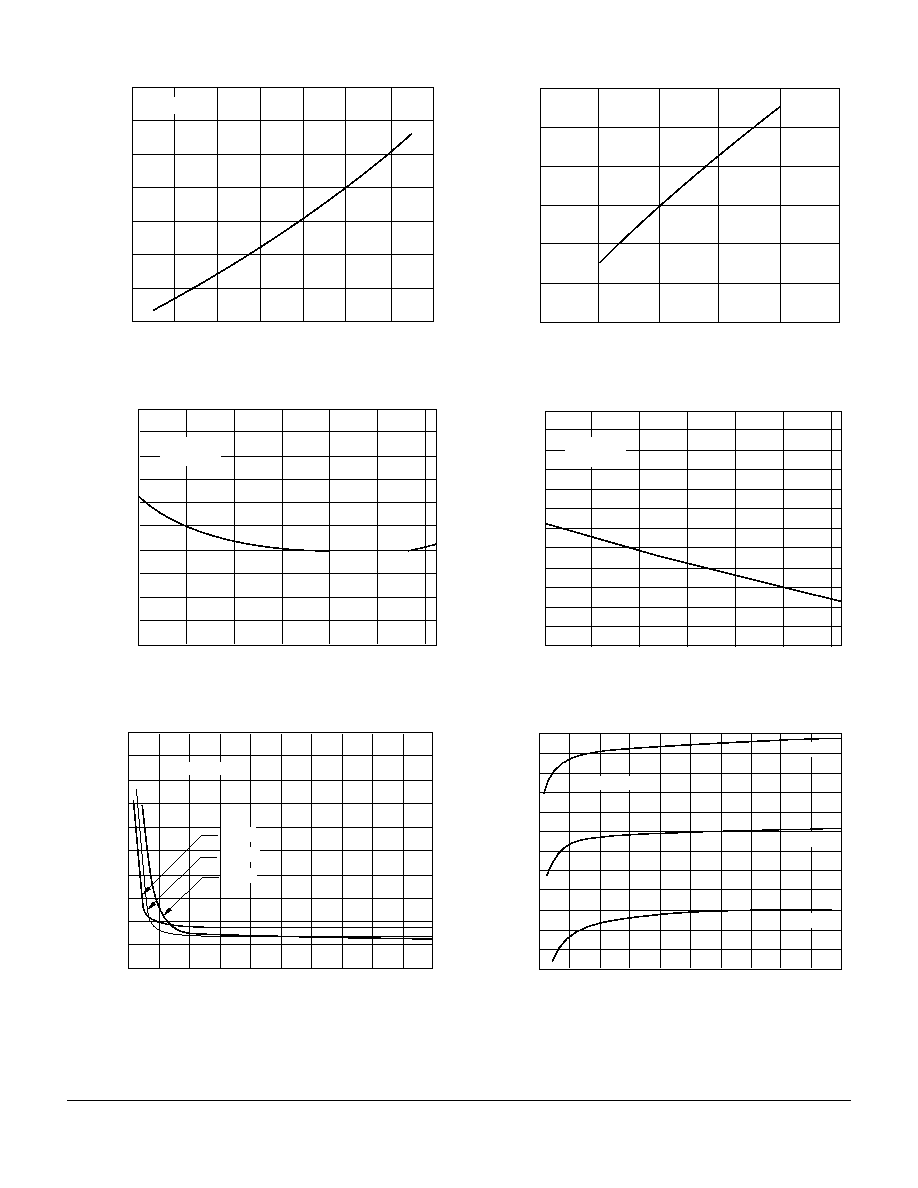
Document Number: 83807
www.vishay.com
Revision 06-March-02
3≠46
FEATURES
∑ Current Limit Protection
∑ l/O Isolation, 5300 V
RMS
∑ Typical
R
ON
20
∑ Load Voltage 350 V
∑ Load Current 110 mA
∑ High Surge Capability
∑ Linear, AC/DC Operation
∑ Clean Bounce Free Switching
∑ Low Power Consumption
∑ High Reliability Monolithic Receptor
∑ SMD Lead Available on Tape and Reel
AGENCY APPROVALS
∑ UL ≠ File No. E52744
∑ CSA ≠ Certification 093751
∑ VDE 0884 Approval
APPLICATIONS
∑ General Telecom Switching
≠ On/off Hook Control
≠ Ring Delay
≠ Dial Pulse
≠ Ground Start
≠ Ground Fault Protection
∑ Instrumentation
∑ Industrial Controls
DESCRIPTION
The LH1503 relays are DPST normally open switches
(2 Form A) that can replace electromechanical relays in
many applications. The relays are constructed using a
GaAlAs LED for actuation control and an integrated
monolithic die for the switch output. The die, fabricated
in a high-voltage dielectrically isolated technology, is
comprised of a photodiode array, switch control circuity,
and DMOS switches. In addition, these relays employ
current-limiting circuity, enabling them to pass FCC
68.302 and other regulatory voltage surge requirements
when overvoltage protection is provided.
Part Identification
Part Number
Description
LH1503AB
8-pin DIP, Tubes
LH1503AAC
8-pin SMD, Gullwing, Tubes
LH1503AACTR
8-pin SMD, Gullwing, Tape and Reel
pin one ID
.268 (6.81)
.255 (6.48)
.390 (9.91)
.379 (9.63)
.045 (1.14)
.030 (0.76)
4
∞
typ.
.100 (2.54) typ.
10
∞
3
∞
≠9
∞
.300 (7.62)
typ.
.022 (.56)
.018 (.46)
.012 (.30)
.008 (.20)
.130 (3.30)
.110 (2.79)
.150 (3.81)
.130 (3.30)
.035 (.89)
.020 (.51)
.250 (6.35)
.230 (5.84)
4
3
2
1
.031 (0.79)
.050 (1.27)
5
6
7
8
Pin one I.D.
.390 (9.91)
.379 (9.63)
.045 (1.14)
.030 (0.78)
.040 (1.02)
.020 (.51)
4
∞
typ.
.008 (.25)
.004 (.10)
.150 (3.81)
.130 (3.30)
.100 (2.54)
typ.
.050
(1.27)
typ.
.312 (7.80)
.298 (7.52)
.315
(8.00)
typ.
.395 (10.03)
.375 (9.52)
.031 (.79)
typ.
.268 (6.81)
.255 (6.48)
Radius
.010
(2.54)
typ.
10
∞
3
∞
to 7
∞
Package Dimensions in Inches (mm)
DIP
SMD
8
7
6
5
S2'
S2'
S2
S2
S1
S1
S1'
S1'
1
2
3
4
LH1503AB/AAC/AACTR
2 Form A
Solid State Relay

Document Number: 83807
www.vishay.com
Revision 06-March-02
3≠47
Absolute Maximum Ratings,
T
A
=25
∞
C
Stresses in excess of the Absolute Maximum Ratings can cause permanent
damage to the device. These are absolute stress ratings only. Functional opera-
tion of the device is not implied at these or any other conditions in excess of
those given in the operational sections of the data sheet. Exposure to maximum
rating conditions for extended periods can adversely affect device reliability.
Ambient Temperature Range (
T
A
) .................................... ≠40 to +85
∞
C
Storage Temperature Range (
T
stg
) ................................. ≠40 to +150
∞
C
Pin Soldering Temperature (t=10 s max) (
T
S
) ............................. 260
∞
C
Input/Output Isolation Voltage (
V
ISO
) .................................. 5300 V
RMS
Pole-to-Pole Isolation Voltage (S1 to S2)...................................... 500 V
LED Continuous Forward Current (
I
F
) .........................................50 mA
LED Reverse Voltage (
I
R
10
µ
A) (
V
R
) ........................................... 8.0 V
DC or Peak AC Load Voltage (
I
L
50
µ
A) (
V
L
) .............................. 200 V
Continuous DC Load Current (
I
L
)
One Pole Operating.................................................................150 mA
Two Poles Operating ...............................................................110 mA
Peak Load Current (t=100 ms) (single shot) (
I
P
) ................................
Output Power Dissipation (continuous) (
P
DISS
)........................ 600 mW
Refer to Current Limit Performance Application Note for a discussion on
relay operation during transient currents.
Recommended Operating Conditions
100
80
60
40
20
0
-40
-20
0
20
40
60
80
Ambient Temperature (
∞
C)
Load Current (mA)
I
Fon
= 3 to 10 mA
I
Fon
= 2 mA
Electrical Characteristics,
T
A
=25
∞
C
Minimum and maximum values are testing requirements. Typical values are characteristics of the device and are the result of
engineering evaluations. Typical values are for information only and are not part of the testing requirements.
Parameter
Sym.
Min.
Typ.
Max.
Units
Test Conditions
Input
LED Forward Current, Switch Turn-on
I
Fon
--
2.0
3.0
mA
I
L
=100 mA, t=10 ms
LED Forward Current, Switch Turn-off
I
Foff
0.2
0.8
--
mA
V
L
±300 V
LED Forward Voltage
V
F
1.15
1.26
1.45
V
I
F
=10 mA
Output
ON-resistance
R
ON
12
20
25
I
F
=5.0 mA,
I
L
=50 mA
Pole-to-Pole ON-resistance Matching (S1 to S2)
--
--
0.2
2.0
I
F
=5.0 mA,
I
L
=50 mA
OFF-resistance
R
OFF
0.5
5000
--
G
I
F
=0 mA,
V
L
=±100 V
Current Limit
I
LMT
230
270
370
mA
I
F
=5.0 mA, t=5.0 ms
V
L
±6.0 V
Off-state Leakage Current
--
--
0.02
200
nA
I
F
=0 mA,
V
L
=±100 V
--
--
1.0
µ
A
I
F
=0 mA,
V
L
=±350 V
Output Capacitance
--
--
55
--
pF
I
F
=0 mA,
V
L
=1.0 V
--
10
--
I
F
=0 mA,
V
L
=50 V
Pole-to-Pole Capacitance (S1 to S2)
--
--
3.0
--
pF
I
F
=0 mA
--
4.0
--
I
F
=5.0 mA
Switch Offset
--
--
0.15
--
V
I
F
=5.0 mA
Transfer
Input/Output Capacitance
C
ISO
--
1.1
--
pF
V
ISO
=1.0 V
Turn-on Time
t
on
--
1.6
2.5
ms
I
F
=10.0 mA,
I
L
=50 mA
Turn-off Time
t
off
--
0.65
2.5
ms
I
F
=10.0 mA,
I
L
=50 mA

Document Number: 83807
www.vishay.com
Revision 06-March-02
3≠48
Typical Performance Characteristics
Figure 1. LED Voltage vs. Temperature
Figure 2. LED Current for Switch Turn-on vs. Temperature
Figure 3. On-resistance vs. Temperature
Ambient Temperature (
∞
C)
LED Forward Voltage (V)
≠40
≠20
0
20
40
60
80
1.6
1.5
1.4
1.3
1.2
1.1
1.0
I
F
=1.0 mA
I
F
=20 mA
I
F
=50 mA
I
F
=2.0 mA
I
F
=5.0 mA
I
F
=10 mA
-40
-20
0
20
40
60
80
100
120
-40
-20
0
20
40
60
80
Ambient Temperature (
∞
C)
I
L
= 100 mA
LED Forward Current for Switch
T
urn-on (%), Normalized to 25
∞
C
≠40
50
10
30
20
40
≠20
≠30
≠10
≠40
0
≠20
0
20
40
60
80
Ambient Temperature (
∞
C)
I
L
= 50 mA
Change in ON-resistance (%)
Normalized to 25
∞
C
Figure 4. LED Dropout Voltage vs. Temperature
Figure 5. Current Limit vs. Temperature
Figure 6. Variation in On-resistance vs. LED Current
≠40
0
20
Ambient Temperature (
∞
C)
1.20
1.15
1.10
0.95
1.00
40
1.05
80
60
≠20
MIN.
TYP.
I
L
= 100 mA
LED Forward Voltage (V)
≠40
40
10
30
20
0
≠20
≠10
≠40
≠30
≠20
0
20
40
60
Ambient Temperature (
∞
C
)
80
I
F
= 5.0 mA
t = 5.0 ms
V
L
=
SEE ELEC. CHAR
.
Change in Current Limit (%)
Normalized to 25
∞
C
0
1.5
0.5
≠0.5
1.0
0
4
8
12
LED Forward Current (mA)
16
20
I
L
= 50 mA
ac/dc On-resistance Variation (%)
Normalized to Data Sheet
R
ON
Specification at I
F
=5.0 mA

Document Number: 83807
www.vishay.com
Revision 06-March-02
3≠49
Figure 7. Switch Capacitance vs. Applied Voltage
Figure 8. Output Isolation
Figure 9. Leakage Current vs. Applied Voltage at Elevated
Temperatures
0
20
40
Applied Voltage (V)
80
50
70
60
40
20
0
10
60
30
100
80
I
F
=0 mA
T
A
=25
∞
C
f=1.0 MHz
Capacitance (pF)
Frequency (Hz)
100
80
60
40
20
0
10
2
10
3
10
4
10
5
10
6
10
7
Isolation (dB)
V
P
=10 V
R
L
=50
Load Voltage (V)
3.0
2.5
2.0
1.0
0.5
1.5
0
0
50
100
150
200
250
300
350
400
85
∞
C
70
∞
C
50
∞
C
Off-state Leakage Current (nA)
Figure 10. Insertion Loss vs. Frequency
Figure 11. Leakage Current vs. Applied Voltage
Figure 12. Switch Breakdown Voltage vs. Temperature
Frequency (Hz)
0.30
0
0.25
0.20
0.10
0.05
10
2
10
3
10
4
10
5
0.15
R
L
= 600
Insertion Loss (dB)
90
0
50
100
150
200
250
300
Load Voltage (V)
100
70
80
60
40
30
50
20
10
0
350 400
I
F
= 0 mA
T
A
= 25
∞
C
Off-state Leakage Current (pA)
≠40
≠20
0
20
40
60
80
Ambient Temperature (
∞
C)
8
0
4
2
6
≠2
≠6
≠8
≠4
Change in Breakdown Voltage (%)
Normalized to 25
∞
C

Document Number: 83807
www.vishay.com
Revision 06-March-02
3≠50
Figure 13. Switch Offset Voltage vs. Temperature
Figure 14. Turn-on Time vs. Temperature
Figure 15. Turn-on Time vs. LED Current
20
40
Ambient Temperature (
∞
C)
3.5
0
50
70
60
30
3.0
1.5
2.0
2.5
0.5
1.0
80
90
I
F
= 5.0 mA
Switch Offset Voltage (
µ
V)
≠40
≠20
0
20
40
60
80
Ambient Temperature (
∞
C)
60
50
≠20
≠30
≠10
0
10
20
30
40
≠40
I
F
=5.0 mA
I
L
=50 mA
Change in Turn-on Time (%)
Normalized to 25
∞
C
0
10
20
LED Forward Current (mA)
10
8
6
0
2
30
4
50
40
≠40
∞
C
I
L
=50 mA
Turn-on Time (ms)
25
∞
C
85
∞
C
Figure 16. Switch Offset Voltage vs. LED Current
Figure 17. Turn-off Time vs. Temperature
Figure 18. Turn-off Time vs. LED Current
0
10
LED Forward Current (mA)
0.6
0
15
25
20
5
0.5
0.2
0.3
0.4
0.1
Switch Offset Voltage (
µ
V)
120
40
≠40
100
80
60
20
≠20
≠60
0
≠40
≠20
0
20
40
60
80
≠80
160
140
Ambient Temperature (
∞
C)
I
F
=5.0 mA
I
L
=50 mA
Change in Turn-off Time (%)
Normalized to 25
∞
C
0
10
20
0.9
0.8
0.3
30
0.7
50
40
0.6
0.5
0.4
I
L
=50 mA
LED Forward Current (mA)
85
∞
C
25
∞
C
≠40
∞
C
Turn-off Time (ms)




